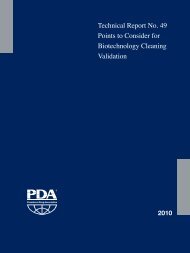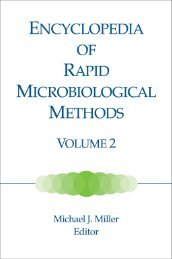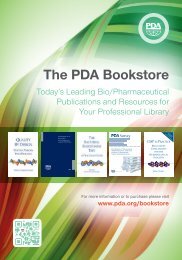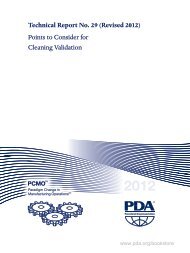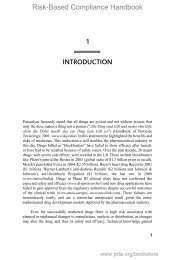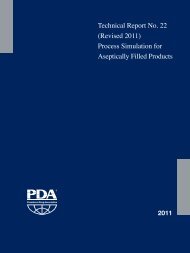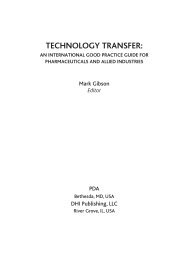Technical Report No. 50 Alternative Methods for Mycoplasma Testing
Technical Report No. 50 Alternative Methods for Mycoplasma Testing
Technical Report No. 50 Alternative Methods for Mycoplasma Testing
Create successful ePaper yourself
Turn your PDF publications into a flip-book with our unique Google optimized e-Paper software.
<strong>Technical</strong> <strong>Report</strong> <strong>No</strong>. <strong>50</strong><br />
<strong>Alternative</strong> <strong>Methods</strong> <strong>for</strong><br />
<strong>Mycoplasma</strong> <strong>Testing</strong><br />
2010<br />
www.pda.org/bookstore
<strong>Alternative</strong> <strong>Mycoplasma</strong> Test <strong>Methods</strong> Task Force*<br />
Authors<br />
David Asarnow, PhD, Bayer HealthCare (Co-Chair)<br />
Kurt A. Brorson, PhD, U.S. Food and Drug Administration (Co-Chair)<br />
Allen L. Burgenson, Lonza Walkersville, Inc.<br />
Vladimir Chizhikov, PhD, U.S. Food and Drug Administration<br />
Timothy A. Coleman, Lonza Walkersville, Inc.<br />
Sven Deutschmann, PhD, Roche Diagnostics GmbH<br />
Thomas E. Haemmerle, PhD, Baxter (Co-Chair)<br />
Mihaela Z. Marian, Amgen<br />
Brandye Michaels, PhD, Pfizer Specialty Care/Biotechnology<br />
Barbara J. Potts, PhD, Biologics Consulting Group*<br />
Cynthia E. Romero-Arroyo, OBI (Johnson & Johnson)<br />
Pranhitha Reddy, Amgen<br />
Kathleen S. Souza, Millipore Corporation<br />
Garry Takle, PhD, WuXiAppTec<br />
Michele Tiraby, Invivogen<br />
Helena M. Windsor, <strong>Mycoplasma</strong> Experience<br />
Contributors<br />
Donna Chandler, PhD, Chandler Vaccine Resources, LLC<br />
Maureen K. Davidson, U.S. Food and Drug Administration<br />
Wang-Ting Hsieh, SAIC-Frederick, Inc.<br />
Scott C. Lute, U.S. Food and Drug Administration<br />
Jill Mariano, PhD, Bionique <strong>Testing</strong> Laboratories, Inc.<br />
Jerold M. Martin, Pall Corporation<br />
Catherine Milne, PhD, EDQM Pharmacopeia<br />
Renate Rosengarten, PhD, Mycosafe Diagnostics GmbH<br />
Radhakrishna S. Tirumalai, PhD, United States Pharmacopeia<br />
Dmitriy Volokhov, PhD, U.S. Food and Drug Administration<br />
Ann War<strong>for</strong>d, DrPH, MedImmune, Inc.<br />
* The <strong>Alternative</strong> <strong>Mycoplasma</strong> Test <strong>Methods</strong> Task Force is a subgroup of the larger<br />
PDA <strong>Mycoplasma</strong> Task Force, which is chaired by Barbara Potts.<br />
The content and views expressed in this technical report are the result of a consensus achieved by the authoring task <strong>for</strong>ce<br />
and are not necessarily views of the organizations they represent or any regulatory authorities. This document is not<br />
intended to be a regulatory guidance.<br />
www.pda.org/bookstore
<strong>Alternative</strong> <strong>Methods</strong> <strong>for</strong><br />
<strong>Mycoplasma</strong> <strong>Testing</strong><br />
<strong>Technical</strong> <strong>Report</strong> <strong>No</strong>. <strong>50</strong><br />
ISBN: 978-0-939459-31-5<br />
© 2010 Parenteral Drug Association, Inc.<br />
All rights reserved.<br />
www.pda.org/bookstore
1.0 Introduction ..........................................................3<br />
1.1 Purpose and Scope ........................................... 3<br />
2.0 Glossary of Terms ................................................4<br />
3.0 Summary of Existing Assays and Compendial<br />
<strong>Methods</strong> ................................................................7<br />
3.1 Limitations of Current <strong>Methods</strong> ........................ 8<br />
3.1.1 The <strong>Testing</strong> Time Period ......................... 8<br />
3.1.2 The Controlled Conditions ...................... 8<br />
3.1.3 <strong>Mycoplasma</strong> Growth .............................. 8<br />
3.2 Background of <strong>Alternative</strong> <strong>Methods</strong> ................. 8<br />
3.3 Applicability and Points of Use of <strong>Alternative</strong><br />
<strong>Methods</strong> in Cell Culture Manufacturing and<br />
Development .................................................... 9<br />
3.3.1 In-process <strong>Testing</strong> of Cell<br />
Culture Harvest Prior to Release<br />
to Downstream Processing .................... 9<br />
3.3.2 <strong>Testing</strong> of Cell Lines and<br />
Research Cell Banks ............................... 9<br />
3.3.3 Use in Bioassay Development .............. 10<br />
3.3.4 Contamination Response and<br />
Corrective Actions................................ 10<br />
3.3.5 Raw Material <strong>Testing</strong> ........................... 10<br />
3.4 Targeted Species ............................................ 10<br />
4.0 Nucleic Acid Amplification<br />
Technique (NAT) <strong>Methods</strong> ..................................13<br />
4.1 Polymerase Chain Reaction (PCR) Overview .. 13<br />
4.1.1 Endpoint PCR ....................................... 13<br />
4.1.2 Real Time PCR ...................................... 13<br />
4.2 Primer and Probe Selection ............................ 14<br />
4.3 Available NAT <strong>Methods</strong> – Direct PCR ............. 14<br />
4.3.1 DNA Endpoint PCR Assays .................. 15<br />
4.3.2 Touchdown PCR Assays ...................... 15<br />
4.3.3 RNA Endpoint PCR Assays ................... 16<br />
4.4 Available NAT <strong>Methods</strong> – Enhanced<br />
PCR and Other <strong>Methods</strong> ................................. 16<br />
4.4.1 Cases Where Low LOD <strong>Methods</strong> are<br />
Required ............................................... 16<br />
4.4.2 Culture/NAT <strong>Methods</strong> of Biological<br />
Enrichment ........................................... 17<br />
4.4.3 <strong>Alternative</strong> RNA Based <strong>Methods</strong> (NASBA<br />
and TMA) ............................................. 18<br />
4.4.4 Sample Concentration Prior to NAT ...... 18<br />
4.5 Sample Volume ............................................... 19<br />
4.6 Nucleic Acid Extraction and Purification ......... 20<br />
4.6.1 Lysis of Cells ........................................ 20<br />
4.6.2 Nucleic Acid Purification ...................... 20<br />
4.6.3 Inactivation of Nucleases ..................... 21<br />
4.7 Assay Set-up .................................................. 21<br />
Table of Contents<br />
4.7.1 Lab Set-up and Procedures ................. 21<br />
4.7.2 Controls .............................................. 21<br />
4.7.3 <strong>No</strong> Template Controls ......................... 21<br />
4.7.4 Negative Sample Controls .................. 22<br />
4.7.5 Positive Controls ................................. 22<br />
4.7.7 Matrix Spike Controls ......................... 22<br />
4.7.8 Interference Control ............................ 22<br />
4.7.9 Internal Amplification Controls............ 23<br />
4.7.10 Quantitative Standard ......................... 23<br />
4.7.11 Assay <strong>No</strong>ise and <strong>No</strong>n-Specific<br />
Amplification ...................................... 23<br />
4.8 Data Interpretation and Follow-up ................. 23<br />
4.9 Reference Materials ...................................... 24<br />
4.10 Method Validation ......................................... 26<br />
4.10.1 Existing Guidance ............................... 26<br />
4.10.2 Limit Tests .......................................... 26<br />
4.10.3 Specificity .......................................... 27<br />
4.10.4 Limit of Detection (LOD) ..................... 27<br />
4.10.5 Precision ............................................. 27<br />
4.10.6 Robustness ......................................... 28<br />
4.10.7 Reproducibility .................................... 28<br />
4.10.8 System Suitability<br />
(Assay Qualification) .......................... 28<br />
4.11 Comparability Studies to<br />
Previous Assays ........................................... 28<br />
4.11.1 Preparation <strong>for</strong> and Conduct<br />
of a Comparability Study .................... 29<br />
4.11.2 Cross-industry Comparability ............. 29<br />
4.11.3 Genome Copy: CFU Ratio in Genomic<br />
DNA Detection Based <strong>Methods</strong> .......... 30<br />
5.0 <strong>No</strong>n-NAT <strong>Alternative</strong> <strong>Methods</strong> ...........................32<br />
5.1 Immunologic Tests ......................................... 32<br />
5.2 Enzyme-Based <strong>Methods</strong> ................................. 32<br />
5.2.1 ATP Generation by <strong>Mycoplasma</strong> .......... 32<br />
5.2.2 Assay Mechanism ............................... 33<br />
5.2.3 Bioluminescent Detection System ....... 33<br />
5.3 <strong>Mycoplasma</strong> <strong>Testing</strong> Using a<br />
Recombinant Cell Line .................................... 34<br />
5.4 <strong>No</strong>n-Amplification Nucleic Acid<br />
Hybridization <strong>Methods</strong> .................................... 34<br />
6.0 Appendices ........................................................35<br />
6.1 Appendix 1: Comparison of <strong>Mycoplasma</strong><br />
<strong>Methods</strong> in Regulations, Compendia and<br />
Guidance Documents Currently in Effect ........ 35<br />
6.2 Appendix 2: In-House Reference Strain<br />
Preparation <strong>Methods</strong> ...................................... 41<br />
6.2.1 Determination of the Titer of Delivered<br />
<strong>Mycoplasma</strong> Reference Strains............ 41<br />
www.pda.org/bookstore
6.2.2 Test <strong>for</strong> Reference Preparation Purity ... 41<br />
6.2.3 Preparation of Cryopreserved<br />
Quantified Cultures ............................... 41<br />
FIGURES AND TABLES INDEx<br />
Table 3.0 Taxonomy and Salient<br />
Characteristics of the Most<br />
Biopharmaceutically Relevant<br />
Genera of the Class Mollicutes ...7<br />
Table 3.4 <strong>Mycoplasma</strong> Species<br />
Associated with Different<br />
Source Material Types ...............11<br />
Figure 4.1.1 One Potential PCR <strong>Mycoplasma</strong><br />
Detection Scheme .....................13<br />
Table 4.3.2 Comparison of PCR <strong>Methods</strong> .....16<br />
Table 4.7.5 Types of Standards <strong>for</strong> Use in<br />
Validation of a NAT Method <strong>for</strong><br />
<strong>Mycoplasma</strong> Detection ..............25<br />
7.0 References ..........................................................43<br />
Table 5.2.1 Representative <strong>Mycoplasma</strong><br />
Species and Their Energy-<br />
Generating Pathways.................32<br />
Figure 5.2.1-1 Endpoint of <strong>Mycoplasma</strong>-Specific<br />
Glucose Fermentation ................33<br />
Figure 5.2.1-2 Endpoint of <strong>Mycoplasma</strong>-Specific<br />
Arginine Lysis .............................33<br />
Figure 5.2.3-1 Luciferase Bioluminescence<br />
Pathway <strong>for</strong> ATP Quantification ..33<br />
Figure 5.2.3-2 Representative Ratio<br />
of Bioluminescence Signal<br />
to Background (B/A) of an<br />
Uninfected control and a Sample<br />
Containing M. hyorhinis ............34<br />
www.pda.org/bookstore
1.1 Purpose and Scope<br />
1.0 Introduction<br />
The scope of this <strong>Technical</strong> <strong>Report</strong> is the application of non-culture testing methodology, including<br />
Nucleic Acid Amplification Technique (NAT) assays and others (e.g., enzyme activity based), <strong>for</strong> detection<br />
of mycoplasmas, members of the class Mollicutes, in cell cultures and biologics. The purpose<br />
of the <strong>Technical</strong> <strong>Report</strong> is to describe assay procedures, assay validation, demonstration of comparability<br />
to reference methods, and potential applications <strong>for</strong> alternative mycoplasma testing methods.<br />
www.pda.org/bookstore<br />
<strong>Technical</strong> <strong>Report</strong> <strong>No</strong>. <strong>50</strong> © 2010 Parenteral Drug Association, Inc.<br />
3



